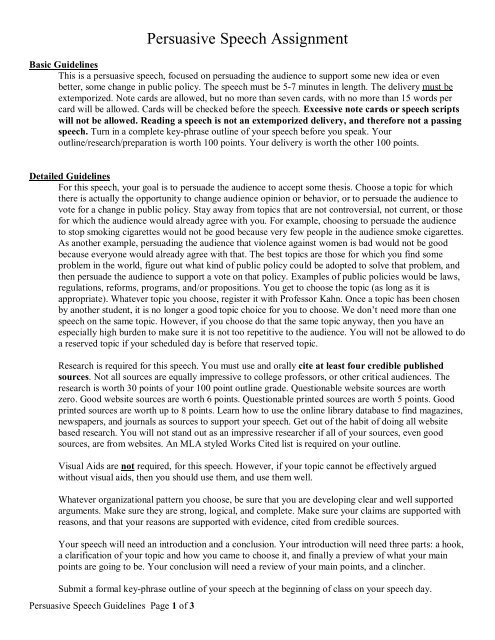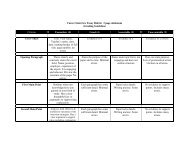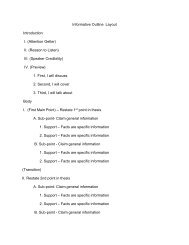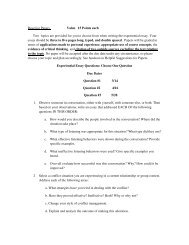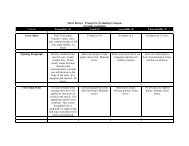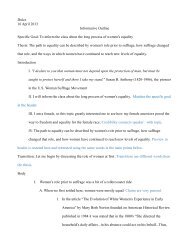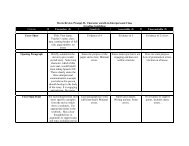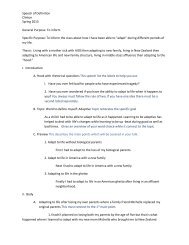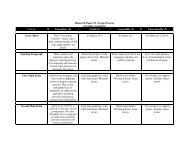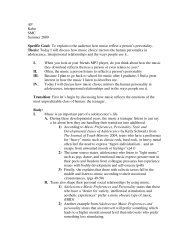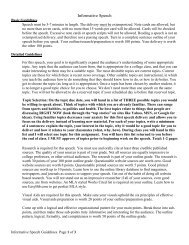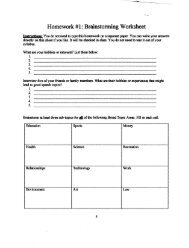Persuasive Speech Assignment - Speechsuccess.net
Persuasive Speech Assignment - Speechsuccess.net
Persuasive Speech Assignment - Speechsuccess.net
Create successful ePaper yourself
Turn your PDF publications into a flip-book with our unique Google optimized e-Paper software.
<strong>Persuasive</strong> <strong>Speech</strong> <strong>Assignment</strong><br />
Basic Guidelines<br />
This is a persuasive speech, focused on persuading the audience to support some new idea or even<br />
better, some change in public policy. The speech must be 5-7 minutes in length. The delivery must be<br />
extemporized. Note cards are allowed, but no more than seven cards, with no more than 15 words per<br />
card will be allowed. Cards will be checked before the speech. Excessive note cards or speech scripts<br />
will not be allowed. Reading a speech is not an extemporized delivery, and therefore not a passing<br />
speech. Turn in a complete key-phrase outline of your speech before you speak. Your<br />
outline/research/preparation is worth 100 points. Your delivery is worth the other 100 points.<br />
Detailed Guidelines<br />
For this speech, your goal is to persuade the audience to accept some thesis. Choose a topic for which<br />
there is actually the opportunity to change audience opinion or behavior, or to persuade the audience to<br />
vote for a change in public policy. Stay away from topics that are not controversial, not current, or those<br />
for which the audience would already agree with you. For example, choosing to persuade the audience<br />
to stop smoking cigarettes would not be good because very few people in the audience smoke cigarettes.<br />
As another example, persuading the audience that violence against women is bad would not be good<br />
because everyone would already agree with that. The best topics are those for which you find some<br />
problem in the world, figure out what kind of public policy could be adopted to solve that problem, and<br />
then persuade the audience to support a vote on that policy. Examples of public policies would be laws,<br />
regulations, reforms, programs, and/or propositions. You get to choose the topic (as long as it is<br />
appropriate). Whatever topic you choose, register it with Professor Kahn. Once a topic has been chosen<br />
by another student, it is no longer a good topic choice for you to choose. We don’t need more than one<br />
speech on the same topic. However, if you choose do that the same topic anyway, then you have an<br />
especially high burden to make sure it is not too repetitive to the audience. You will not be allowed to do<br />
a reserved topic if your scheduled day is before that reserved topic.<br />
Research is required for this speech. You must use and orally cite at least four credible published<br />
sources. Not all sources are equally impressive to college professors, or other critical audiences. The<br />
research is worth 30 points of your 100 point outline grade. Questionable website sources are worth<br />
zero. Good website sources are worth 6 points. Questionable printed sources are worth 5 points. Good<br />
printed sources are worth up to 8 points. Learn how to use the online library database to find magazines,<br />
newspapers, and journals as sources to support your speech. Get out of the habit of doing all website<br />
based research. You will not stand out as an impressive researcher if all of your sources, even good<br />
sources, are from websites. An MLA styled Works Cited list is required on your outline.<br />
Visual Aids are not required, for this speech. However, if your topic cannot be effectively argued<br />
without visual aids, then you should use them, and use them well.<br />
Whatever organizational pattern you choose, be sure that you are developing clear and well supported<br />
arguments. Make sure they are strong, logical, and complete. Make sure your claims are supported with<br />
reasons, and that your reasons are supported with evidence, cited from credible sources.<br />
Your speech will need an introduction and a conclusion. Your introduction will need three parts: a hook,<br />
a clarification of your topic and how you came to choose it, and finally a preview of what your main<br />
points are going to be. Your conclusion will need a review of your main points, and a clincher.<br />
Submit a formal key-phrase outline of your speech at the beginning of class on your speech day.<br />
<strong>Persuasive</strong> <strong>Speech</strong> Guidelines Page 1 of 3
Grading Criteria<br />
Strive for strong extemporization. This means that you will have spent enough time writing a clear<br />
speech and practicing it properly that you can deliver it with strength and confidence, without relying<br />
too heavily on your notes. You cannot pass by reading your speech.<br />
Strive for meaningful eye contact and connection with the audience. Maintain that connection and be<br />
sure to connect with all areas of the audience.<br />
Strive for good gestures and body movements. Move your body to a different part of the stage when you<br />
transition between main points. Avoid distracting movements such as playing with jewelry, hands in<br />
pockets, or pacing/dancing/rocking movements with your feet and body.<br />
Strive for a professional appearance. Dress professionally. Casual, every-day attire fails to establish<br />
personal ethos. To be an A-level speaker, you must dress like an A-level speaker.<br />
Strive for a dynamic delivery. That is, you should seem to be interested in your own speech, and you<br />
should communicate that enthusiasm to the audience with your vocal style and body movements.<br />
Strive for appropriate and variable vocal pitch, volume, rate, and tone, based on the nature of the speech<br />
content.<br />
Strive for clear and interesting external transitions between main points.<br />
Strive for a flawless formal, logical and complete outline. To be formal, the outline should use formal<br />
and consistent notation style and indentation. It should be a final draft without errors. It should be<br />
stapled and clean. To be logical, it should demonstrate logical subordination and coordination. To be<br />
complete, it should show, in logical outline format, all the speech content in key phrase format. See the<br />
sample outline on this document for a good model of what your outline might resemble.<br />
Personal Checklist<br />
I want an A on this speech, so I will make sure of the following:<br />
I will choose a topic that will be a current, controversial, and a good use of the audience’s time.<br />
I will not read my speech. I will speak from minimal note cards.<br />
I will dress to impress on my speech day.<br />
I will be on time on my speech day.<br />
I will have my outline neatly printed and stapled.<br />
I will practice my speech many times so that I know how long it will be.<br />
I will create and practice an interesting hook for the very beginning of my speech, without using false starts.<br />
I will create and practice external transitions between my main points.<br />
My research will demonstrate impressive skills at finding highly credible, printed sources.<br />
I will speak with passion and enthusiasm, making it clear that the arguments are important to me.<br />
<strong>Persuasive</strong> <strong>Speech</strong> Guidelines Page 2 of 3
Sample <strong>Persuasive</strong> <strong>Speech</strong> Outline<br />
Please visit Prof. Kahn’s webpage to see sample persuasive outlines. This Work Cited shows ample evidence of<br />
reliable resources. It all shows the level of detail your work cited must include.<br />
Works Cited<br />
Graw, M., and H.G. Konig. "Fatal Pedestrian–bicycle Collisions." Forensic Science International 126.3 (2002):<br />
241. Academic Search Premier. Web. 11 Aug. 2001.<br />
Rehfeld, Barry. "A Two-Wheeled Option (with a Battery) for Commuters."" New York Times 6 May 2007, sec.<br />
3: 5. National Newspaper Core. Web. 10 Aug. 2011.<br />
"Sharing the Road With Bicycles." Automobiles, Motorists, Traffic Safety and Driving Guidelines. - Smart<br />
Motorist. Web. 11 Aug. 2011. .<br />
"Sharing the Streets." Editorial. Washington Post 2 May 2001, sec. A: 14. National Newspapers Core. Web. 11<br />
Aug. 2011.<br />
"Traffic Safety Facts: 2009 Data." National Highway Traffic Safety Administration. U.S. Department of<br />
Transportation, 2009. Web. 11 Aug. 2011. .<br />
Webster, Richard A. "New Orleans French Quarter Group Wants to Put Brakes on Scofflaw Bicyclists." New<br />
Orleans City Business 28 Aug. 2009. MasterFILE Premier. Web. 11 Aug. 2011.<br />
<strong>Persuasive</strong> <strong>Speech</strong> Guidelines Page 3 of 3


